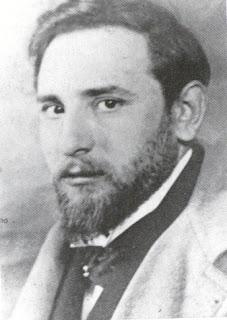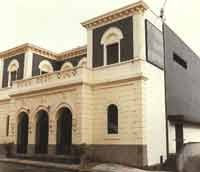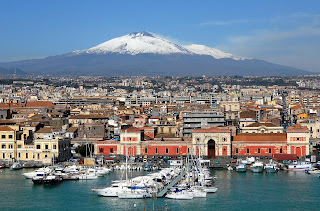Sicilian who popularised coffee and gelato in 17th century Paris
The chef and café proprietor Procopio Cutò, who opened one of the earliest coffee houses in Paris and has been credited with introducing Italian ice cream to the French capital, was born in Sicily on this day in 1651.
Procopio Cutò, born in Sicily, founded
the most successful café in Paris
Cutò, whose full name was Francesco Procopio Cutò and at times called himself Francesco Procopio dei Coltelli, or François Procope, was the owner and founder of the Café Procope, which thanks to its illustrious clientele can claim to have been the first literary coffee house in Paris.
The café opened for business in 1686 and traded continuously for around 200 years before closing in the late 19th century.
The name was revived in the 1950s and the original premises in Rue de l'Ancienne Comédie - in the Saint-Germain-des-Prés quarter on the left bank of the Seine - is again called Café Procope, although it is now a restaurant rather than a coffee house.
It was thought for many years that Cutò was born in Aci Trezza, a town on Sicily’s eastern coast, a little over 10km (six miles) north of Catania, the island’s second largest city. However, the discovery of baptismal certificate in the archives of the Church of Sant'Ippolito in the Capo district of Palermo suggests he was born in the capital.
The surname Cutò, while common in Sicily at the time of his birth, is of Greek origin. The first name Procopio was inspired by the Greek historian Procopius.
Although there is evidence that flavours were added to snow and ice as a refreshment in ancient Rome and Greece, ice cream had yet to be produced commercially as Cutò was growing up.
 |
| Café Procope's elegant and luxurious decor attracted an upmarket, intellectual clientele |
With dreams of making his fortune by producing and selling his ices, Cutò chose to try his luck in Paris because, with a population of half a million, the French capital was at the time the largest city in Europe.
Having travelled through mainland Italy, he is thought to have arrived there at some point between 1670 and 1674. He took jobs along the way, in one of which he acquired cooking skills, joined a guild of drinks-makers soon after reaching Paris and becoming apprenticed to an Armenian, called Pascal, who had a kiosk serving lemonade and coffee on Rue de Tournan. It was one of the first such establishments to call itself a café. When Pascal moved to London in 1675, he allowed Cutò to take over.
In the meantime, using the gelato-making methods he had learned from his grandfather, Cutò developed a range of flavoured ices and successfully applied for a licence to sell them from his kiosk. In search of a bigger market, he opened a second stall at the nearby Foire Saint-Germain, a large covered marketplace which staged annual fairs that could accommodate 300 merchants.
_-001.jpg) |
| The writer Voltaire, who was a Procope regular |
Cutò believed that if he changed the image of the coffee house, he could appeal to a wealthier, more sophisticated branch of Parisian society. With that aim, he bought up a redundant bath house, stripped out all its bathing facilities and repurposed it as a luxury meeting place, with crystal chandeliers, wall mirrors and marble tables.
It soon became a place where stylish gentlemen would develop a taste for coffee and Cutò’s fruit sorbets, which were served in porcelain cups by elegant waiters.
Cutò’s big break came in 1689, when the Comédie-Française opened its doors in a theatre across the street from his café. A new crowd of young intellectuals began to frequent the Café Procope, establishing the venue as one of the first literary cafes.
Over time, the likes of Voltaire, Maximilien Robespierre, Victor Hugo, Pierre Beaumarchais, Jean-Jacques Rousseau and Honoré de Balzac would become regulars. Oscar Wilde and Henry Wadsworth Longfellow are also known to have visited, along with American political luminaries such as Benjamin Franklin and Thomas Jefferson. Even Napoleon Bonaparte took coffee there.
 |
The Café Procope, in Rue de l'Ancienne Comédie, is still in business today as a thriving restaurant |
The Café Procope thus became the most famous and successful café in Paris and is credited with turning France into a coffee-drinking society.
Cutò, who married three times and fathered at least 14 children, became wealthy as a result. Having adopted the surname Dei Coltelli soon after arriving in Paris when his name was misspelled as Couteaux - the French word for knives (coltelli in Italian) - in 1702 he changed it to François Procope not long after becoming a French citizen.
In 1716, he handed the running of Café Procope to his second son, Alexandre. Cutò continued to run his kiosk at the Foire Saint-Germain before passing away in 1727 at the age of 76.
Travel tip:.jpg)
The dramatic rock formation off the coast at Aci
Trezza is known as the Islands of the Cyclops
Aci Trezza, which for many years was thought to have been the birthplace of Procopio Cutò, is a small fishing town within easy reach of the Sicilian city of Catania that has become a popular resort. It has rocky volcanic beaches which look out over some dramatic rock formations in the sea known as the Islands of the Cyclops, sometimes called the Faraglioni of Trezza. The main part of the town is clustered around the harbour and the Chiesa Madre di San Giovanni Battista, Aci Trezza’s parish church. Many houses have been painted in pastel colours. The town is particularly lively in the evening thanks to its reputation for having outstanding fish restaurants. The town hosts a fish festival every July. Its connection with Cutò may have arisen because Aci Trezza is one of many towns that sit in the shadow of Mount Etna, where snow from the upper slopes used to be collected for turning into sorbets. It is possible that Cutò may have visited the area while perfecting his recipe for gelato.
Travel tip:
The daily Mercato di Capo runs the whole length
of the Via Sant'Agostino in the centre of Palermo
Capo, the neighbourhood of Palermo where Procopio Cutò is likely to have been born, is one of the original four quarters of Palermo established during the Spanish rule of the city, which lasted from early 15th century until Italy became a unified country in the 19th century. Also known as Seralcadi, derived from the Arabic name Sari al Cadì, the area nestles between Palermo’s duomo - the Cattedrale della Santa Vergine Maria Assunta - the Teatro Massimo, and Via Maqueda, one of the city’s main thoroughfares. The largest opera house in Italy, able to accommodate an audience of 1,350 people, the Renaissance-style Teatro Massimo opened in 1897, with an initial capacity of 3,000. It closed in 1974 for supposedly minor repairs but a lack of funding prevented its re-opening for 23 years. A major attraction for visitors to Capo is the huge, historic outdoor street market, which occupies virtually the length of Via Sant’Agostino, selling everything from fresh fish, fruit and vegetables to clothes, household items and local handicrafts. Street food can be found in abundance, in particular the Sicilian specialities - arancini, cannoli and panelle.
Also on this day:
1621: The election of Pope Gregory XV
1770: The birth of classical guitarist and composer Ferdinando Carulli
1891: The birth of left-wing politician Pietro Nenni
1953: The birth of boxer Vito Antuofermo
1953: The birth of missionary Ezechiele Ramin






.jpg)


.jpg)
.jpg)
.jpg)






















